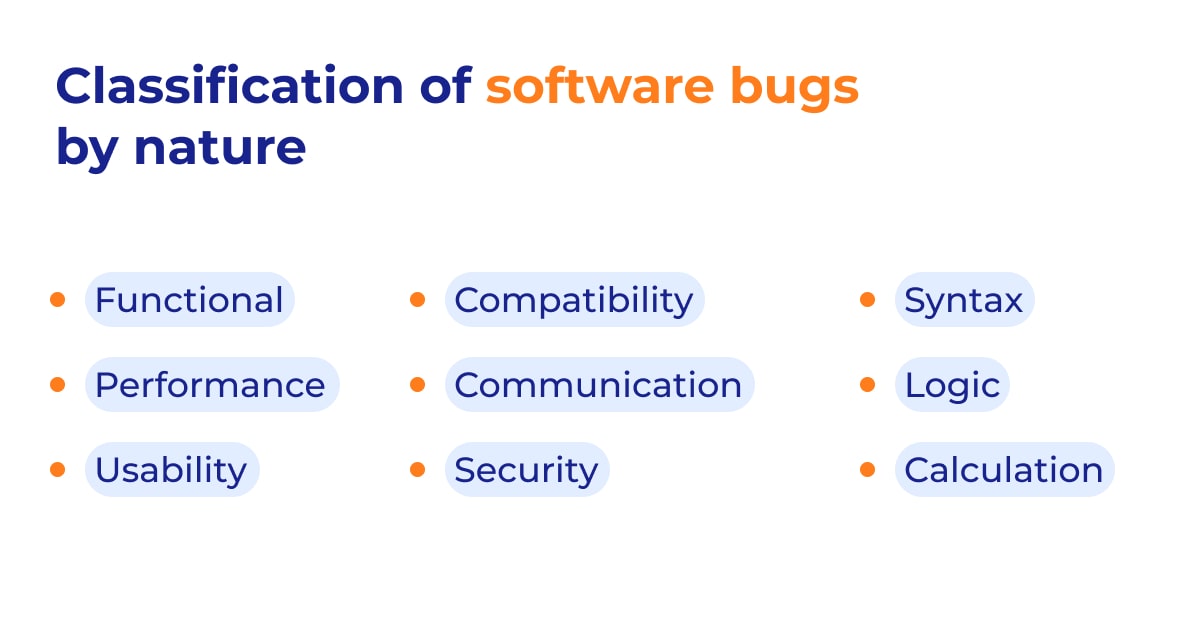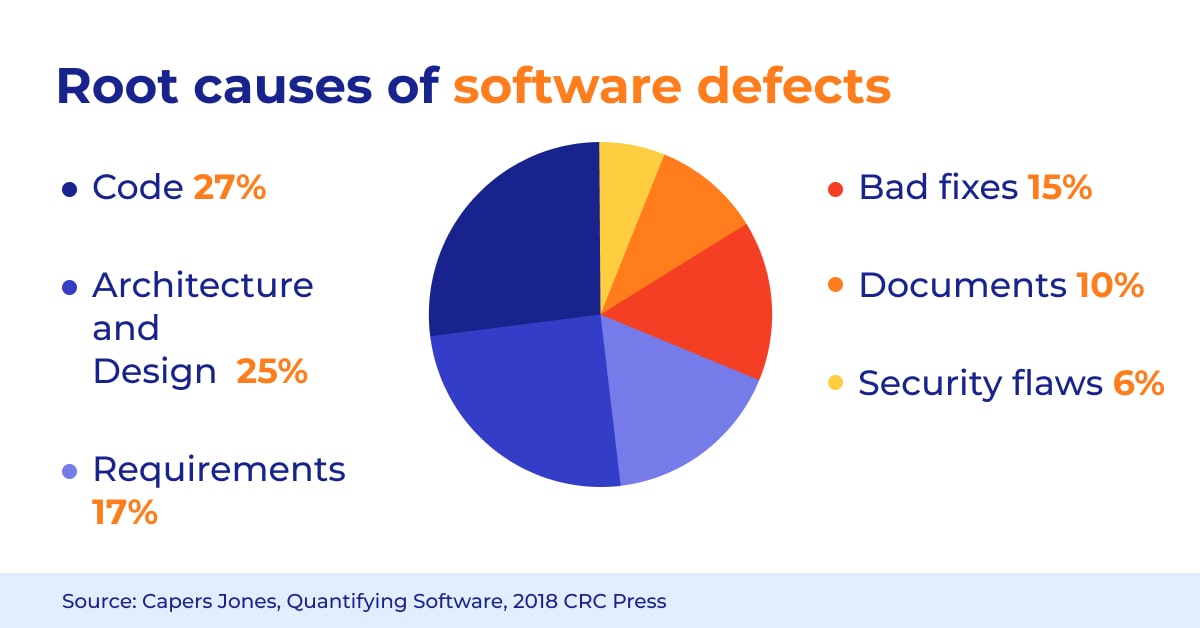Types of Bugs in Software Testing
by Nataliia Vasylyna | March 24, 2011 10:00 am
Note: the article was updated in May 2022.
Today, software teams face a lot of pressure to write large lines of code quickly, efficiently, and accurately to meet all business and customer requirements. In addition to this, up-to-date projects are becoming more complex and require more time and effort for testing. Naturally, this leads to an increase in the number of bugs.
Errors, anomalies, and bugs should be identified, recorded, and corrected. This article covers the most common bugs of varying severity[1]. By being aware of these types of defects and other common mistakes[2], the software development staff can solve software defects in the most likely cases.
What is a Software Bug?
A software bug is a problem causing a program to crash or produce invalid output. The problem is caused by insufficient or erroneous logic. A bug can be an error, mistake, defect, or fault, which may cause failure or deviation from expected results.
Software bugs should be caught during the testing phase of the software development life cycle, but some can go undetected until after deployment.

Functional errors
This broad type of error occurs whenever software does not behave as intended. For example, a Login button doesn’t allow users to login, an Add to cart button that doesn’t update the cart, a search box doesn’t respond to a user’s query, etc. So basically, any component in an app or website that doesn’t function as intended is a functional bug. These types of defects are discovered via functional testing[3].
Performance bugs
A type of software bugs, errors are related to speed, stability, response time, and software resource consumption. Such defects are discovered during the performance testing phase.
Usability defects
A usability defect makes the software difficult or inconvenient, such as a complex registration form. This type of error prevents the user from using the software to its full potential. Software engineers and UX designers must review their software against the Web Content Accessibility Guidelines and other usability requirements to detect such errors.
Compatibility errors
These software bugs occur when an application does not run consistently across different hardware, operating systems, and browsers. An example would be a defect related to a font size that renders ideally in Safari but has the wrong size in Google Chrome. A worse example of a fault could be the inability to use the software on the top best-selling devices on the market. Such bugs can be found through compatibility testing[4].
Communication errors
This type of error arises when a communication breakdown occurs between software and the end-user. For example. a communication bug is bound to occur during the software use if it contains undocumented features. For seamless and effective communication between both parties, software should be easy to use and provide all necessary instructions and recommendations for users to interact with a program.

Security bugs
Security errors are perhaps one of the most severe defects, making the project vulnerable. This type of bugs opens the software, company, and customers to a potential intense attack. There are various approaches to structuring a security vulnerability. For example, the Open Web Application Security Project (OWASP) lists ten security threats. The most common are encryption errors, susceptibility to SQL injection, XSS vulnerabilities, buffer overflows, and inferior authentication.
Syntax errors
Such errors occur in the program’s source code and prevent the program from compiling correctly. This type of defect is widespread and usually occurs when there are one or more missing or incorrect characters in the code. For example, missing one parenthesis can cause a syntax error. Compiling programs typically indicate where a syntax error has ensued.
Logic bugs
One of the types of coding errors that can cause the program to output incorrectly or even freeze or crash. A common logical fallacy is an infinite loop (a piece of coding that lacks a functional exit so that it repeats indefinitely). It causes the program to repeat the sequence of actions indefinitely until it crashes or halts due to external intervention, such as the program closing or a power outage.
Calculation errors
Calculation errors may occur due to bad logic, an incorrect formula, a data type mismatch, coding errors, or function. While such an error can be costly in specific contexts — like in banking, where an incorrect calculation can result in the loss of money[5] — hunting down the calculation error is typically just a matter of math.
Studying the classification of defects will simplify their prioritization and speed up the elimination. It is important to remember that bugs have different categories and typings. Professional QA specialists are not only well versed in testing theory but also successfully apply knowledge in practice. If you want to be sure of the quality of the product, entrust the work to professionals and leave us a request[6].
Learn more from QATestLab
Related Posts:
- varying severity: https://blog.qatestlab.com/2015/03/10/software-bugs-severity-levels/?utm_source=blog&utm_medium=article&utm_campaign=types-of-bugs-in-software-24032011
- other common mistakes: https://blog.qatestlab.com/2019/06/04/software-testing-errors/?utm_source=blog&utm_medium=article&utm_campaign=types-of-bugs-in-software-24032012
- functional testing: https://qatestlab.com/services/manual-testing/functional-testing/?utm_source=blog&utm_medium=article&utm_campaign=types-of-bugs-in-software-24032013
- compatibility testing: https://qatestlab.com/services/manual-testing/compatibility-testing/?utm_source=blog&utm_medium=article&utm_campaign=types-of-bugs-in-software-24032014
- loss of money: https://blog.qatestlab.com/2019/09/05/bugs-impact-business/?utm_source=blog&utm_medium=article&utm_campaign=types-of-bugs-in-software-24032015
- leave us a request: https://qatestlab.com/request-a-quote/?utm_source=blog&utm_medium=article&utm_campaign=types-of-bugs-in-software-24032016
- Main Types of Defects in Software Testing: https://blog.qatestlab.com/2011/10/11/main-types-of-defects-in-software-testing/
- 2 Groups of Significant Software Bugs: https://blog.qatestlab.com/2013/11/05/2-groups-of-significant-software-bugs/
- What Is the Biggest Bug Producer?: https://blog.qatestlab.com/2016/03/30/biggest-bug-producer/
Source URL: https://blog.qatestlab.com/2011/03/24/3-types-of-bugs-in-software/

